
Scottie Scheffler won the 2022 Masters Championship this past weekend, and I have decided to analyse his golf swing action.
Scottie Scheffler is obviously a very skilled golfer who can drive the ball both long and straight. I have never previously examined his golf swing action, and I decided after his recent superlative Masters' Championship performance to analyse his golf swing action in great depth.
I searched you-tube for slow motion golf swing videos, and this was the best slow motion video of his golf swing action that I have presently discovered.
https://www.youtube.com/watch?v=d4vdN6R9SuA&t=147s
I will start of by examining features seen in his face-on swing video, and I will then discuss features that are more apparent in his DTL videos.
Capture images of his backswing and early-mid downswing action.

Image 1 is at address. I have drawn two vertical red lines upwards from a point on the ground that is just outside his two feet. Note that his pelvis is centered between his feet. Note that he has a small degree of rightwards spinal tilt. Note that he has a weak lead hand grip, and also a weak trail hand grip.
Image 2 is at his P4 position. Note that he maintains his trail knee bend unchanged during the P1 => P4 time period, and he does not allow his pelvis to laterally sway (shift) rightwards away from the target during his backswing action (as recommended by Kwon). Note that his trail hip joint is driven into a biomechanical condition of marked internal rotation by P4. Note that he has a centralised pelvic loading pattern and a rightwards-centralised upper torso loading pattern. Note that he rotates his shoulders ~110-120 degrees and that torques his spine around more to give him the "look" of arching his spine targetwards using an arch-extension maneuver (as recommended by Kwon). However, he is not really using an arch-extension (reverse pivoting) manuever and that "look" is simply due to the fact that his upper thoracic spine is rotating clockwise >90 degrees. Note that he has high hands at P4 and he can get his lead arm to the 11:30 o'clock position. Because he only rotates his pelvis ~50 degrees clockwise between P1 => P4, he is generating a lot of static X-factor at his P4 position.
Image 3 is at his P4.3 position. Note that he is rotating his pelvis counterclockwise as he initiates his hip-squaring action and that there is simultaneously a small degree of targetwards pelvic shift motion happening at the same time. Note that he does not start his counterclockwise pelvic rotation between P3.5 => P4 (as recommended by Kwon) and he only starts to rotate his pelvis counterclockwise after P4.
Image 4 is at his P5 position. Note that he has completed his hip-squaring action and that he manifests the "Sam Snead sit-down" look where both hip joints are increasingly flexed and both femurs are in a state of external rotation in their respective hip joints. Note that his trail thigh is less vertical (compared to his lead thigh) because his pelvis has shifted targewards to a significant degree during his hip-squaring phase.
Image 5 is at his P5.5 position. Note that he has shifted his pelvis targetwards a lot, but the outer border of his lead pelvis is still well within the vertical boundary of his lead foot. Note that he keeps his head stationary while his pelvis is shift-rotating between P4 => P5.5, and that allows him to generate a lot of secondary axis tilt.
Capture images of his late downswing action.
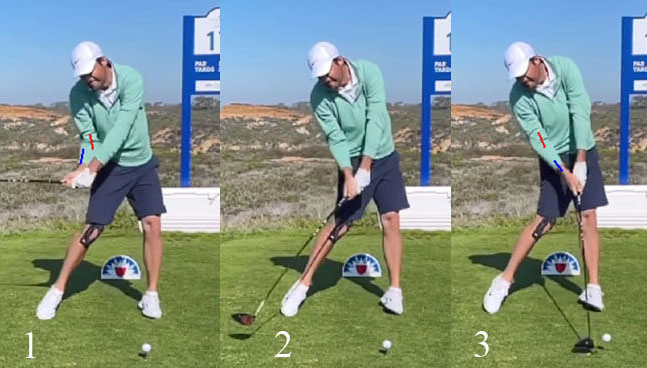
Image 1 is at his P6 position. I have drawn a red line down the middle of his trail antecubital fossa and a blue line along his lower radial bone in his lower trail forearm. Note that the blue line is rotated clockwise relative to the red line by a large amount, which indicates that his trail forearm is markedly supinated. Note that his trail palm is partially under the club handle secondary to his marked degree of trail forearm supination, but it is still seemingly on top of his club handle due to the fact that he has a weak trail hand grip. Note that the back of his lead hand and watchface area of his lead forearm are both facing the ball-target line. Note that his trail elbow is still bent at a right-angle and it is positioned in a pitch location alongside, and just above, his trail hip joint area. Note that his lead wrist is still radially deviated and that he has a ~110 degree clubhead lag angle.
Image 2 is at his P6.5 position. Note that he is releasing PA#2 due to a lead wrist uncocking action. Note that the back of his lead hand and watchface area of his lead lower forearm is still facing the ball-target line to a significant degree, which means that he has not yet released PA#3 (secondary to a lead forearm supinatory motion) to any significant degree. Note that his clubface is still significantly open relative to his clubhead arc and also relative to the ball-target line.
Image 3 is at impact where he has squared his clubface relative to his clubhead arc and also relative to the target. Note that the back of his lead hand and watchface area of his lead lower forearm are nearly facing the target at impact, and that he squared his clubface by impact by performing a PA#3 release, which is biomechanically due to lead forearm supination. Note that his trail forearm is still slightly supinated at impact, and he does not have a pronated trail forearm at impact (as recommended by Mike Adams/ Terry Rowles for golfers who adopt a weak trail hand grip). Note that he still has a partially bent trail ebow and incompletely straightened trail wrist at impact - and he does not allow his trail palm to roll-over his lead palm through impact due to trail forearm pronation combined with a simultaneous "running-out-of-trail arm" phenomenon (which Mike Adams/Terry Rowles recommend for golfers who adopt a weak trail hand grip).
Note that he has a lot of secondary axis tilt and right lateral bend at impact. Note that his trail shoulder and upper-lateral chest area are not "covering" the ball (which Mike Adams/Terry Rowles recommend for a golfer who adopts a weak trail hand grip).
I think that Scottie is essentially performing a pivot-induced lead arm swinging action (TGM swinging action using an intact LFFW/GFLW technique) and that he is not actively using his trail arm/hand to power or control his club's motion. His trail arm/hand is mainly being used as a RFFW unit to support the motion of his intact LFFW during his downswing action.
Capture images of his early followthrough action.
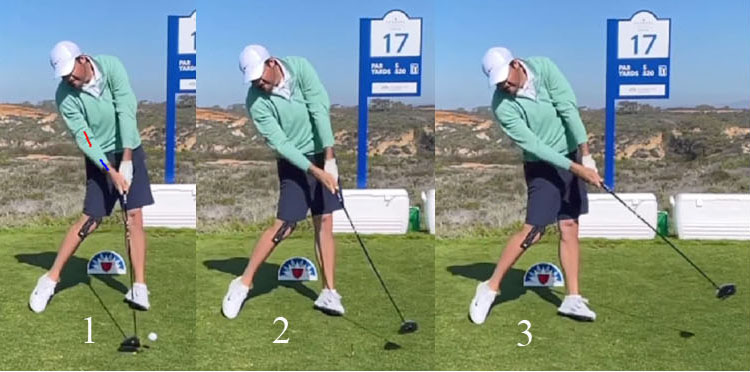
Image 1 is at P7, image 2 is at P7.3 and image 3 is at his P7.5 position.
Note that Scottie's clubface is relatively square to his clubhead arc during his early followthrough time period, and that he is using a borderline DH-hand release action. The term "borderline" means that he is not a perfect DHer who prevents the clubshaft from bypassing his lead arm (from an angular rotational perspective) between P7 => P7.2+, and one can note that his clubshaft is bypassing his lead arm (from an angular rotational perspective) between P7.3 => P7.5 due to a lead wrist extension phenomenon that causes the clubshaft to flip slightly ahead of his lead arm. The amount of lead wrist flipping that is happening is very small, and one can note that there is seemingly no lead wrist circumductory motion happening during his lead wrist flipping motion that can increase the clubface ROC during that early followthrough time period.
Here is a comparative capture image of Cameron Champ's DH-hand release action.

Note how much Cameron Champ's lead hand is moving targewards between P7 (image 1) and P7.5 (image 3) due to the fact that he keeps his lead arm moving targetwards fast enough between P7 => P7.5 to allow him to perfectly match his lead arm's targetwards motion to the clubshaft's targetwards momentum (from an angular rotational perspective). That fact requires a finite amount of lead arm abduction during the P7 => P7.5 time period.
Note that Scottie Scheffler keeps his lead arm adducted against his upper left-sided chest wall between P7 => P7.5 and that his lead hand is only a few inches ahead of the outer order of his lead thigh at P7.5. That produces a very small degree of difference in the speed of targetwards motion of his lead arm (when compared to Cameron Champ), which can causally result in a non-DH hand release action (flipping subtype) through impact.
Another small difference between Scottie Scheffler's and Cameron Champ's hand release action is that Scottie "runs-out-of-trail arm" sooner (due to the fact that his trail shoulder remains further back) and that causes his trail wrist to straighten by P7.5 - while Cameron still has a slightly bent trail wrist at P7.5. I personally do not think that that this small differencee is biomechanically relevant because I suspect that they both use a passive trail arm/wrist straightening action through impact, and they do not use an active slap hinge hand release action involving a positive trail hand torque phenomenon through impact. I suspect that both Scottie and Cameron have a negative hand couple phenomenon happening at the exact moment of impact, which potentially provides for greater lead wrist stability through impact.
Note that both Scottie and Cameron have a very open pelvis and upper torso alignment at impact, and also well beyond impact to P7.5, which is very conducive to efficiently performing a no-roll subtype of hand release action through impact. Note that both Scottie and Cameron do not allow their lead humerus to externally rotate between P7 => P7.2+ (which is routinely seen in pro golfers who use a delayed full-roll subtype of DH-hand release action through impact).
Here is a DTL capture image of Scottie Scheffler's early followthrough action in his driver swing.
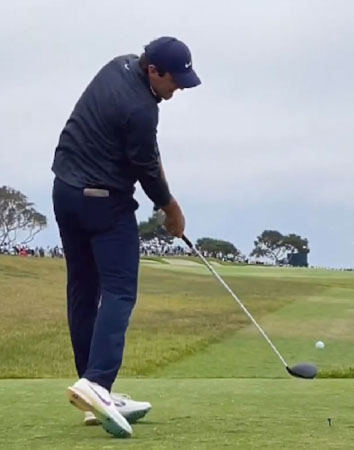
Note that his clubface is still square to his clubhead arc despite the fact that he he probably has a very small degree of lead wrist flipping motion happening in his early followthrough time period between P7 => P7.4.
Here are DTL capture images of his early followthough when swinging an iron.
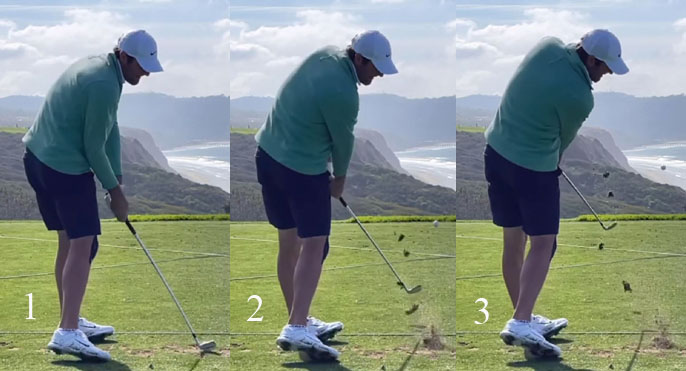
Image 1 is at P7, image 2 is at P7.2 and image 3 is at P7.4.
Note that he has an open pelvis and slightly open upper torso alignment at impact. Note how much he continues to rotate his pelvis and upper torso counterclockwise between P7 => P7.4 and that allows him to efficiently perform a CP-arm release action combined with a no-roll DH-hand release action during that time period, which then allows him to keep his clubface square to his clubhead path all the way between P7 => P7.4.
Now, consider Scottie's footwork through impact.

Image 1 is at impact. Note that his lead ankle is inverted and that he is rolling his ankle so that he likely has a lot of pressure-loading over the outer border of his lead foot at impact. I suspect that it is secondary to the fact that he has lot of targetwards pelvic shift motion happening during his downswing action.
Note that his lead heel is grounded while he is lifting up his lead forefoot. I suspect that it is due to the fact that he is probably a front-foot golfer who has a large amount of rotary pelvic torque happening between P5.5 => P7.5. In fact, he seemingly has so much counterclockwise pelvic rotary torque being generated by the active muscular contraction of his lead gluteus maximus muscle that his lead femur externally rotates a lot through impact - note how his lead thigh rotates counterclockwise between P7 => P7.5 causing his lead knee cap to face more targetwards by P7.5 and it also causes his lead forefoot to spin counterclockwise at the same time. In some of his more vigorous driver swings, his pelvis rotates so assertively counterclockwise through impact that it causes his lead heel to move backwards away from the ball-target line during his early followthrough action - as can be seen in the following video at https://www.youtube.com/watch?v=g18IUXdFj1E .That "lead heel shift" phenomenon creates a momentary unbalancing motion, but it only happens post-impact (mainly in his driver swing action) and I suspect that it does not necesarily affect the pre-impact quality of his lead arm/clubshaft motion during his late downswing and at impact.
Now, I will examine a series of his DTL capture images in order to discover more features of his golf swing action.
DTL capture image of his backswing action.
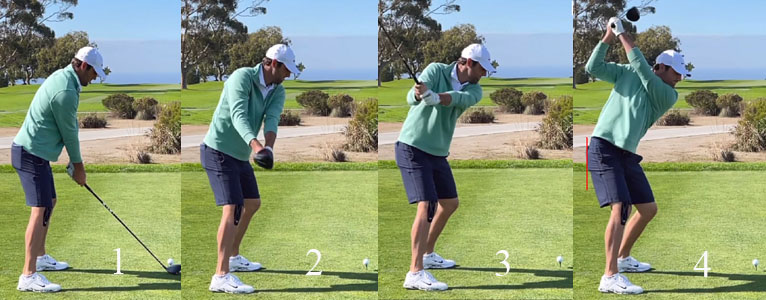
Image 1 is at address. Note that his original shaft plane is intermediate in degree of steepness between the hand plane and the elbow plane and that is probably due to his more upright address posture.
Image 2 is at P2. Note that his clubshaft is parallel to the ground and his clubface is vertical with the toe pointing straight up. His clubface is straight-in-line parallel to the back of his lead hand and watchface area of his lead lower forearm because he uses a weak lead hand grip and he also uses an intact LFFW/GFLW swing technique.
Image 3 is at P3. Note that he uses a trail arm folding action that is intermediate in degree between a Right Forearm Takeaway technique and an One-Piece takeaway technique. Note that the butt end of his club is pointing at the ball-target line at P3, which means that his clubshaft is on-plane. If you watch his slow motion video, you will note that he uses an on-plane clubshaft motion technique combined with an intact LFFW/GFLW technique during his backswing action.
Image 4 is at P4. Note that his lead arm is slightly steeper than his shoulder turn angle, and that his clubshaft is positioned just above the TSP. Note that his RFFW is perfectly aligned relative to his intact LFFW at P4, which nessitates that he manifest a flying right elbow scenario at P4.
Note that his clubshaft is pointing slightly left of the target at P4. That fact is simply due to the factual reality that he rotates his upper torso >90 degrees by P4 and it is not due to any swing fault involving his arms/wrist/hands (eg. excessive lead wrist cupping that disrupts his intact LFFW/GFLW alignment).
Also, note that his clubhead is higher than his hands at P4 secondary to a clubshaft angle that is angled slightly upwards, which is partly due to the fact that his trail wrist is not very extended at his P4 position.
Here is a comparison capture image of Dustin Johnson at his P4 position.
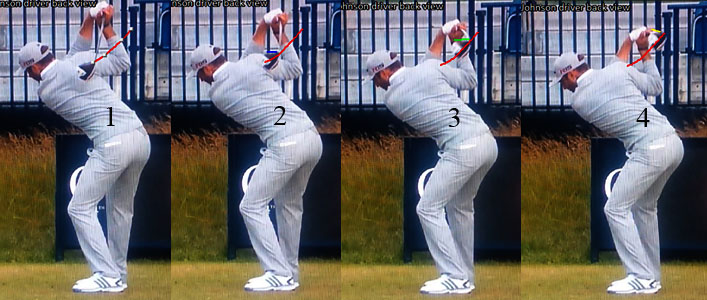
Image 1 is his P4 position - note that his clubshaft is angled groundwards at P4 so that his clubhead is well below the level of his hands. What is causing that groundwards clubshaft angulation phenomenon? It is significantly due to the fact that Dustin has a very bowed lead wrist and a very extended trail wrist that allows him to position his clubshaft in a much more "laid-off" position at P4.
Note how extended Dustin's trail wrist is at the start of his early downswing action - images 2, 3 and 4.
Does that more extended trail wrist give Dustin Johnson an advantage over Scottie Scheffler in terms of swing power? I have seen a number of golf instructors express an opinion that having a very extended trail wrist at P4 is advatangeous because it allows for a greater range of trail wrist motion between P4 (when the trail wrist is very extended) and impact (when the trail wrist is minimally extended). I personally reject that opinion because I do not think that any trail wrist straightening motion (moving from marked extension at P6 => minimal wrist extension at P7) increases clubhead speed in a pro golfer who uses a pivot-induced lead arm swinging action (like Dustin Johnson and Scottie Scheffler). I will greatly expand on this issue in a future thread.
DTL capture images of Scottie Scheffler's early-mid downswing action.

Image 1 is P4, image 2 is at P4.5, image 3 is at P5, image 4 is at P5.5 and image 5 is at P6.
Note that I have drawn a red line against the back of his trail buttock at P4, and that represents the tush line.
Note how Scottie starts his hip-squaring action by rotating his lead buttock back towards the tush line while keeping his trail buttock abutted against the tush line. I suspect that his hip-squaring action between P4 => P4.5 is mainly due to the muscular activation of his trail-sided lateral pelvic rotator muscles +/- due to his lead forefoot generating a horizontal GRF by pushing away from the ball-target line.
Note that he has completed his hip-squaring action by P5 and his trail buttock has only moved away from the tush line by ~2". Note that his pelvis is open by P5.5 while his shoulders are still slightly closed.
Note that he has very little head dropping during his hip-squaring action, and he maintains his spinal bend inclination angle constantly unchanged between P4 => P6.
Note how actively he adducts his right upper arm between P4 => P5 - note how his trail elbow, which is level with his lead elbow at P4, drops below the level of his lead elbow by a large amount by P5. That active right arm adduction manuver, which is combined with a pitch elbow motion, allows him to efficiently retain his clubhead lag angle of ~90 degrees, and avoid casting, during his clubshaft shallowing action.
Note how he shallows his clubshaft from being just above the TSP at P4 to being approximately on the elbow plane by P5.5. The two major biomechanical actions that make this clubshaft shallowing action possible are i) an active right arm adduction maneuver using a pitch elbow motion and ii) a large amount of trail forearm supination.
Note that he has an on-plane clubshaft motion between P4 => P6 and that his clubshaft ends up being parallel to both the ground and the ball-target line at P6 and lying vertically above his toe line at P6. Note that the toe of his clubface is pointing straight-up, which means that it is not square to his clubhead arc.
Note that I have drawn a short blue line parallel to his clubface at P5.5 (image 4) and it is wide-open relative to his clubhead arc. I strongly suspect that Mike Malaska would label this open clubface alignment at P5.5 a major swing fault, and he has repeatedly stated that it will require an inordinate amount of clubface rolling (due to a lot of lead forearm supination happening after P6) in order to get a square clubface by impact from that wide-open clubface position at P5.5. Mike Malaska wants to avoid having to use a lot of lead forearm supination in his later downswing and he therefore recommends his "Malaska Move" maneuver, which he wrongheadedly believes is absolutely necessary to get the clubface square to the clubhead arc by P6. Many modern-era golf instructors also recommend a clubface closing maneuver between P4 => P5.5 in order to avoid having that open clubface alignment at P5.5. For example, Tyler Ferrell recomends the Motorcycle Move (more correctly called the Reverse Motorcycle Move) and Brian Manzella recommends his Twistaway Maneuver. Miles Lino and Eric Cogorno also recommend a lead wrist flexing maneuver in the following video at https://www.youtube.com/watch?v=LM_GJSZo9oo .
By contrast, I don't think that Scottie's clubface can be defined as being wide open at his P5.5 position and I believe that his clubface alignment is actually neutral and naturally expected because he uses the combination of i) a weak lead hand grip and ii) an intact LFFW/GFLW technique and an iii) on-plane clubshaft motion during his downswing action. Why do I claim that it is naturally expected for Scottie to have his clubface lying back in an open position (relative to his clubhead arc) at his P5.5 position? First of all, Scottie uses a weak lead hand grip, which means that his clubface will be straight-in-line with the watchface area on the back of his lower lead forearm if he has a GFLW alignment and an intact LFFW alignment. Because Scottie uses the intact LFFW/GFLW technique throughout his entire downswing action, his clubface will always be straight-in-line/parallel to his lead lower forearm's lower radial bone throughout the entire P4 => P7 time period. Secondly, Scottie also maintains an on-plane clubshaft throughout his downswing action, which means that when his clubshaft is shallowing-out down to the elbow plane between P4 => P5.5, his clubshaft is always lying on his instantaneous swingplane at every instantaneous moment between P4 => P5.5. Note that his clubface is lying on the surface of his instantaneous swingplane at P5.5 (image 4). Note that the watchface area of his lead lower forearm is also straight-in-line with that instantaneous swingplane at P5.5. Finally, because his clubface is straight-in-line with his watchface area on the back of his lower lead forearm at P5.5, that means that his clubface must also lie parallel to the surface of his swingplane at P5.5.
Here is a capture image of Scottie Scheffler at his P5.5 position.
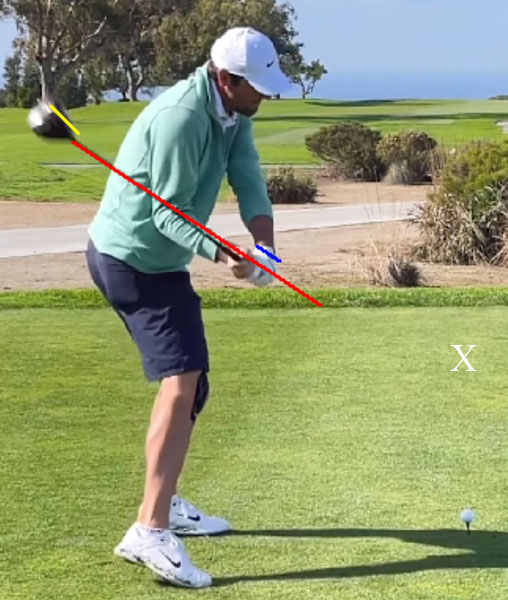
The red line shows his clubshaft lying on his instantaneous swingplane at his P5.5 position. An imaginary extension line drawn out from the butt end of his club will point at the "X" mark on the ground, and point "X" is positioned on the ball-target line. That means that his clubshaft is on-plane at his P5.5 position.
I have drawn a blue line parallel to the watchface area of the back of his lead lower forearm and that blue line goes straight through his lower lead forearm's radial bone just above the level of his lead wrist crease. That blue line is straight-line-aligned with his clubface because he has an intact LFFW/GFLW alignment at P5.5. Because he adopts a weak lead hand grip, his clubface (yellow line) must be straight-line-aligned with both the blue line and the red line. In other words, his clubface must have that very specific alignment at P5.5 if he has i) an intact LFFW/GFLW alignment where ii) the clubshaft is on-plane on his instantaeous swingplane at his P5.5 position. If his clubface was more closed at that P5.5 position, then it would suggest he is using a superadded clubface closing maneuver (eg. Reverse Motorcycle Move) that is not necessary if one uses the intact LFFW/GFLW technique.
To get a square clubface by impact, Scottie Scheffler simply has to use a PA#3 release action during his later downswing - as demonstrated in the following capture image.
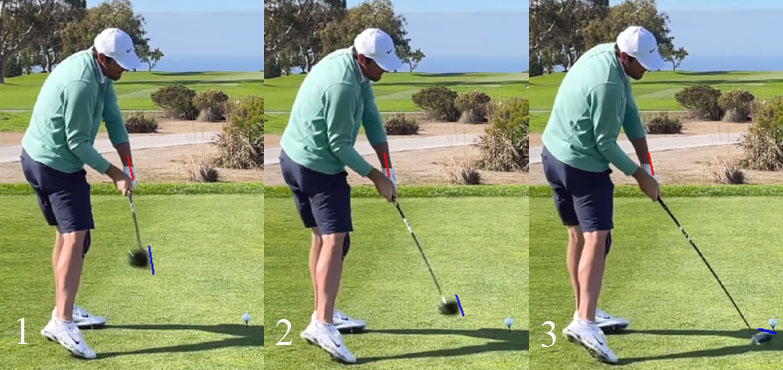
Image 1 is at his P6 position. I have drawn a short red line through the axis of his lead lower forearm's lower radial bone and a blue line parallel to his clubface. Note that the red and blue lines are straight-line-aligned because he has an intact LFFW/GFLW alignment.
Image 2 is at his P6.5 position. Note that the red and blue lines are still straight-line-aligned due to the fact that he maintains an intact LFFW/GFLW during his later downswing.
Image 3 is at the P6.8 position. Note that the red and blue lines are still straight-line-aligned due to the fact that he maintains an intact LFFW/GFLW during his later downswing - while he is simultaneously releasing PA#2 and PA#3.
Scottie Scheffler obviously has no problem consistently timing his release of PA#3 (which is primarily due to lead forearm supination) so that he consistently gets a square clubface at impact, and that allows him to consistently hit straight shots.
Many pro golfers have chosen to use the optional choice of using a weak lead hand grip combined with an intact LFFW/GFLW technique and notable examples include Tiger Woods and Justin Thomas.
Here is a capture image of Tiger Woods PA#3 release action from the Nike commercial video - captured in the early 2000's when he used a weak lead hand grip and when his golf swing action was at his personal career best.
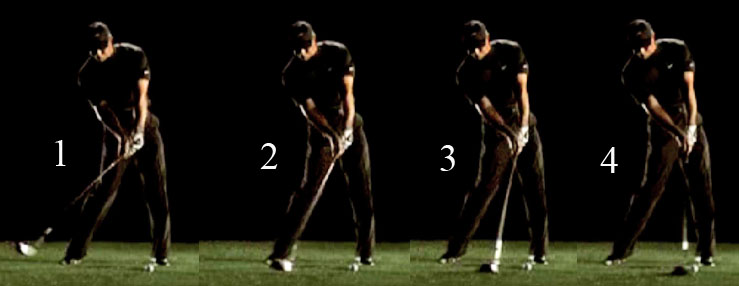
Image 1 is at P6.5 and image 4 is at impact.
Note how he steadily rotates the back of his lead hand counterclockwise between P6.5 => P7 due to a PA#3 release action (which is primarily due to lead forearm supination), and how his clubface is steadily closing during the P6.5 => P7 time period.
A pro golfer who chooses to use a weak lead hand grip can use either the intact LFFW/GFLW technique or the bowed lead wrist technique - as described in my downswing chapter here at https://perfectgolfswingreview.net/downswing.htm#topic6
Scottie Scheffler, Tiger Woods and Justin Thomas have chosen to use the intact LFFW/GFLW technique while Jon Rahm, Collin Morikawa and Jordan Spieth have chosen to use the bowed lead wrist technique. Both techniques require a lot of lead forearm supination in the later downswing between P6.5 => P7, and the I think that the only major advantages of the bowed lead wrist technique is that it makes it easier to acquire forward shaft lean at impact and I also suspect that a bowed lead wrist at impact is likely to be more mechanically stable at impact than a non-bowed lead wrist. However, I know of no evidence that demonstrates that it is easier to time the release of PA#3 when using the bowed lead wrist technique (compared to the intact LFFW/GFLW technique). Scottie Scheffler superlatively demonstrates how a skilled pro golfer can use the trio combination of a i) weak lead hand grip, ii) an intact LFFW/GFLW technique and a iii) continuously on-plane clubshaft motion between P4 => P7 to consistently hit straight shots at his desired target.